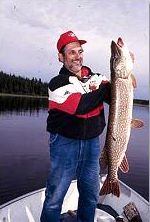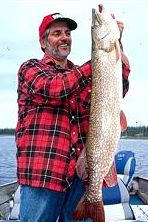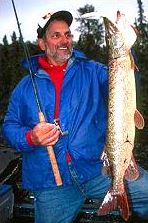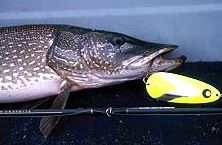Getting out-fished by someone in your boat is a humbling experience, but when that someone is a 13-year old, a jaw can get awful tight. At least I wasn’t alone, as his father was also experiencing the same luck as I was having… watching the youngster catch 3-4 pike to our one. I couldn’t figure it out. We were fishing wide, flat, shallow bays that had scattered pike, and after a while, identical spoons were on all three rods. There was no first cast into an area that was best, or some edge the youngster was fishing we didn’t know about. Yet something was going on under the surface that we hadn’t figured out.
The Drop-Back
I began to do less fishing and more looking out of the corner of my eye, scrutinizing the boys every move. Like many young men his age, his attention span was not like an adults, even though he was catching fish. He’d stop reeling to talk, to take a bite of sandwich or drink of soda, to readjust his clothes, or to watch an eagle soar past. Soon it became evident that when his retrieve was halted then restarted, most strikes would occur.
Now things began to make sense, but before deciding to clue his dad in on what was going on, I decided to give the “pause concept” a try. For the next 30-minutes I was
consistently into pike, and after building up a safe lead over his dad (25-cents a pike can add up in good Canadian waters), the secret came out.
What we didn’t realize was that a lot of pike were following our lures, then turning off as they neared the boat. Through the years we found this to be a common occurrence with post-spawn pike that hadn’t really started to feed yet. But this was the late 70’s, and the day when we first realized this was occurring.
When ever the young man stopped reeling the spoon would flutter down, but more importantly, the tapered spoons would backup toward the pike. Most pike were lazily following in a straight retrieved spoon, and would spook to the side as the lure neared the boat. But when the retrieve was halted, (and as we further discovered) the rod tip dropped back towards the spoon, the lure would flutter backwards from 18-inches to 4-feet, right back into a following pikes face. And if there is a best way to trigger a following pike (or muskie) cruising behind a lure into striking, the in their face approach is tops.
The distance a lure will flutter backwards is determined by the style of the spoon, depth of the water, and how the falling, flat spoon planes as it sinks. Try this next to the boat. Have 5-6 feet of line between the lure and rod tip. Move the spoon through the water parallel to the boat’s side, then stop and drop the rod tip back towards the lure. This gives the lure some line so it can back up the maximum distance. Clear shallow water will give you the best view of how the drop-back works. The best drop-back spoons I’ve used are the size 6 Lindy Gator Spoon, Eppinger TrollDevle, and the 1-ounce standard Dardevle.
The Drop-Back technique is a great way to trigger following pike.
Summary: Whenever casting spoons for pike, especially if conditions are tough, try dropping the lure back several times on each retrieve. This is a good technique to practice whenever casting a spoon.
Jig-Trolling Spoons
The weed bed was immense, probably 12-15 acres. And it consisted of leafy, cabbage weeds, with much of the growth in the 9-12 foot depths, a condition that usually causes the pike to cruise in and out through the open water between the clumps looking for food. This sprawling mass of vegetation could take some time to fish, since there was no wall-like edge that would tend to concentrate numbers of pike, and so much of the weed bed looked like perfect pike habitat.
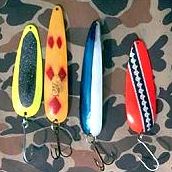
My next option would be to run a spinnerbait or buzz-bait across the surface. But what tossed this plan for a loop, was that hundreds of dark, shadowy weed pockets existed throughout the vegetation. And due to the bright sky conditions, light winds and fairly clear water, you could sense the pike were holding in those weedy lairs. But there had to be a way of rooting them out, and I didn’t intend on wasting hours of time casting to all those potential fish-holding areas. I had to figure out a fast way of working those weeds.
If the weed bed was smaller, I would have probably jig fished it with plastic-bodied lizards, reapers, big double twister tails, Sassy Shads, or other types of soft-bodied “creatures.” At least these presentations would penetrate down into the weeds, and the single hook on the jig would allow me to snap and rip through any clinging vegetation.
Finally I had an idea, why not try a Johnson Silver Minnow, but instead of casting with it troll with varying speeds in a lazy S pattern. This prevented the lure from following the boat’s path. When turning toward the lure it would sink into the weeds, but as the boat swung the other way the lure would be on the outside of the turn, going faster and swimming out of the weeds. The method worked like a charm, as the spoon was actually being jigged down into the weeds, then pulled out, while the boat was constantly moving over new waters in the search for pike.
Since this experience occurred 6 or 7 years ago, I’ve had excellent success with this technique, rooting many pike out of weedy cover that would not come up for a high-running, more horizontal presentation. But there are certain things that must be done for maximum success.
The plated hook on a Silver Minnow is dull and must be sharpened along the sides and tip with a fine grain file. South Bend makes a great one. Adjust the weed guard so it lines up with the hooks tip and extends out a little past it. If the hook point and weed guard aren’t in a straight line, you’ll grab a lot more weeds. Don’t adjust the wire weed guard too far out from the point or it will be too hard to set. Adjust the setting according to the density of the vegetation.
Trolling silver minnows gives you a great way to cover
massive weed beds and to get down into the vegetation.
My first attempts at setting the hook, while making turns with stretchy, mono wrapped around weed clumps, were disastrous. Most hook-ups on larger fish occurred after quickly gunning the motor to pick up line as the hook was being set. As the technique evolved , here’s what I found to work best. Use no-stretch super line such as Berkley WhipLash or FireLine. Don’t use a shorter rod or one that doesn’t have backbone. A muskie “bucktail rod” that’s at least 6 foot 9 inches, or a sturdy flippin’ stick are recommended for maximum hook-setting power. Longer rods give you a long, sweeping hook-set that picks up slack line, they also keep the lure a little farther from the boat, plus they aid in controlling and playing pike.
Dress the Silver Minnow with pork or plastic. A dressing’s length and bulk will alter how fast or slow the spoon will wiggle or sink. Be careful not to use a soft plastic dressing that slides up on the hooks shank every time a sharp forward rip is executed to clear weeds. Gluing some plastics to several spoons with a “Krazy” glue can solve this problem. The standard silver-colored “Silver Minnow” is a must, but gold, perch and fire tiger can also be hot, especially when the water has some color, or darker skies exist.
Summary: When faced with lots of weeds, trolling can help to quickly find the pike. But be careful not to go too fast in a straight line. A soft zigzag pattern allows the lures to constantly sink down and be pulled out of the weed clumps. It’s this “jigging action” that roots out the big ones!
Flutter Spoons
When game fish are aggressive, fishing fast and horizontal is often the best way to cover water and catch the maximum amount of fish. But as the action starts to decrease, slower speeds and lures that fall, flutter or pause usually become more productive. A slower falling lure may also be more effective on suspended fish, or those holding tight to cover, as it gives them a little more time to zero in on the presentation.
Wafer-thin “flutter spoons” like those used for trolling salmon and trout
are slow falling with a lot of flash that trigger non-aggressive pike.
Anyone with basic pike fishing experience knows that spoons are tops for these toothy predators, and we’ve already discussed two deadly tactics. But the ultimate “tease” technique, the tactic that temps even the most tight-jawed pike into hitting a spoon, is the one that gives us the slowest, falling, most tantalizing action. This involves casting with super-light weight flutter spoons, those wafer thin spoons that are usually trolled in deeper water for trout or salmon while using weights or planer devices to get them down.
Before going out and trying to cast these spoons on baitcasting gear spooled with heavy line, three words of advice-don’t try it! They are best fished with long-handle spinning rods that are at least 6 1/2 to 7 feet long, and a reel full of soft 10-14 lb. test mono such as Trilene XL, or better still 14-20 lb. test FireLine. Two handed “snap casts” are recommended, where a right-handed caster pulls the butt section of the rod sharply towards his body with the left hand, while the right hand fires out the cast. This tactic increases rod speed to give extra casting distance. Look at a South Bend System 9 IM6 graphite spinning rod I designed (P-246) to get an idea of the type rod to use. A ball-bearing, wide-spool spinning reel with a tapered spool works best.
Flutter spoons have a lot of flash and movement with a minimal amount of forward or drop speed. You can slow the frantic fluttering action down a bit by adding a plastic or pork trailer, but I rarely do.
These spoons won’t let you cover a lot of territory, but they are deadly under certain situations. One of them is when sight fishing for pike. Although this may sound easy it’s not. In stained waters only slight shadows or dark spots on the bottom may be noted. In clear water the fish can more easily be seen, but a cast made too close will usually send them bolting away. Always cast at least 10-15 feet past the pike, and not directly over it. If the fish is moving, cast well in front. Even if you lead the pike too far, let the spoon sit on the bottom until the fish is within 5-8 feet. The lift up and allow the spoon to flutter downward. Sometimes the pike may just watch the lure sink, and nose up to within inches of the lure. Short little jiggles or soft “pops” will usually provoke a strike.
A flutter spoon can also be rigged on a follow-up rod. When a pike follows in a faster-moving, more horizontal presentation then turns off, a flutter spoon can be blind cast in the direction the fish headed. Let it sink 5-6 seconds pull it upward, then repeat. This slow-falling, crippled action is often different enough to trigger a response.
Flutter spoons also work well when allowed to sink into larger holes in a weed bed, or into the shaded areas between higher clumps. Let the light lure slowly flutter down into the pocket a few feet, or down between the clumps, then left the rod to pull it back out. These thin spoons sink much slower than a conventional spoon, and have a wilder, flashing action. This attracts pike and gives them plenty of time to react to the slow falling lure.
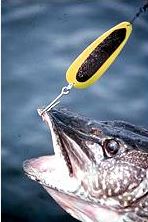
Wire leaders should be used with all the spoon techniques discussed. Always use a quality ball-bearing snap-swivel to the lure. A size 4 Berkley Cross-Loc snap swivel is ideal. When casting a spoon, either with the drop-back technique or with a flutter spoon, a 12-inch leader is perfect. When trolling with the Silver Minnow, where a lot of pulling and ripping of weeds is going on, a 3-foot leader is better as it will slice through the vegetation and won’t weaken. Put these 3 techniques in your pike-fishing bag of tricks and watch your catches soar!
